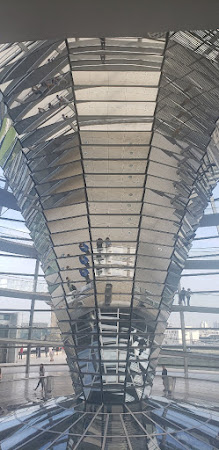I was actually more excited to visit Germany than England. I'm a huge fan of WWII. (I know that's a strange, morbid thing to say, but I love history and I find wars fascinating.) And well, what better way to delve into WWII than Germany?
How do I look with a short bob?
German is such a fascinating language. I imagine it is very hard to learn because of how ridiculously long some of the words are!
1. Brandenburg Gate
This famous gate built from 1788~1791 was built by Prussian King Frederick William II is probably the most famous landmark in Germany. It served as the entry gateway to Berlin, symbolizing Berlin and Germany division during the Cold War. Today, the gate actually symbolizes unity.
The statue on top of the goddess of victory riding on a chariot drawn by 4 horses is called the "Quadriga". This changed the meaning of the gate from symbolizing the division of East and West Germany to unity of one Germany and peace.
The Berlin Wall Memorial
The Berlin Wall Memorial is dedicated to the deaths that happened here and commemorates the division of Berlin into East and West:
East Side Gallery
Walking a little further, you will see the East Side Gallery. This is the longest surviving section of the Berlin Wall that divided Germany post-WWII into West and East Germany. East was Communist under the rule of the USSR, and West was Democratic, in allegiance with the US, Britain, and France.
2. Berlin Story Bunker
The only one of its kind, this museum was built as a recreation of the notoriously infamous Fuhrerbunker. It's a horrifyingly fascinating museum that can really affect you emotionally. And you can only visit it as a guided tour.
No photos were allowed inside. They recreated Hitler's study and where he killed himself. This is where I learned that Hitler used to paint. He actually wanted to be a painter. He applied and was twice rejected by the Academy of Fine Arts in Vienna. It is said that Hitler developed his irrational hatred of the Jewish people around this time as a lot of museum owners and some members of the admissions committee who rejected his "art" were Jewish. (Yeah, the ego on this psychopath--maybe your art just sucks!)
They had some prints of his dry, uninspired paintings.
3. The Jewish Museum Berlin
This is the largest Jewish museum in Europe. This museum shows the history of Jewish people in Germany from the Middle Ages to today.
The museum had huge empty spaces with nothing. Daniel Libeskind, the architect, intentionally created these "voids" vertically throughout the museum to represent the absence of Jewish people from German society.
This was my favorite part of the museum, the faces in agony represents the Jewish people's agony during WWII and the Holocaust.
Nearby, you will see the Holocaust Memorial, dedicated to the millions of Jewish people that were murdered in Europe:
Berlin has a "Museum Island" where 5 of their best museums are all located within walking distance from each other.
If you are pressed for time, the Neues Museum should be on the top of your list:
The Neues Mueseum
This is where the famous Nefertiti Bust is located. Discovered in Egypt in 1912 by a German archeologist, the bust was brought back to Germany and unveiled to the public in 1924. Ever since then, Germany and Egypt been fighting over Queen Nefertiti--for over 95 years!
Bode-Museum
Pergamonmuseum
The other 2 museums that I didn't get to visit are the Altes Museum and Alte NationalGalerie.
The Bundestag is the Parliamentary building. As far as I remember, you can't go inside the Bundestag but you can go to the Reichstag, which is atop the Bundestag.
The Reichstag is actually the German Parliament. It explains 3 things: it is the Reichsrat as the Upper Chamber, the building which houses the Bundestag, and the lower chamber of the legislature
It has a glass dome which is open to the public (and free!) that gives you a 360 degree view of Berlin.
The Reichstag was completely renovated from its original state to this futuristic glass model to symbolize Berlin's move away from past Nazism and towards a transparent, democratic Germany.
6. Berlin Victory Column
The Victory Column was designed by Heinrich Strack after 1864 to commemorate the Prussian win in the Dano-Prussian War. It also features as an observation deck that offers a view of Berlin.
7. Berliner Fernsehturm
At 368m high, the Berliner Fernsehturm is the highest structure in Germany. It was built from 1965~1969 by East Germany as a symbol of Communism. Nowadays, it is a television tower with an observation deck with the highest 360 degree views of Berlin.
View of Berlin:
All lit up night!
This cute gift shop with a cutout of Angela Merkel was at the bottom of the Fernsehturm:
Food
Although I was, and still am, trying to avoid red meat, it was pretty much impossible to avoid sausages or sausage-based dishes and beer in Germany.
I absolutely loved trying Käsespätzle for the first time. It was a pasta/noodle-like dish with tons and tons of cheese. It was probably my favorite dish I had in Germany. And this raspberry-flavored beet was also my favorite beer there.
I actually wasn't that fond of currywurst. (I'm just not the biggest fan of sausages/pork/beef.)
But it was available everywhere and I had to try Germany's most popular street snack.
And...Off to the airport I went for my next adventures~
Auf Wiedersehen, Berlin!!








































No comments:
Post a Comment